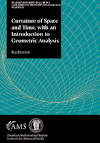- About MAA
- Membership
- MAA Publications
- Periodicals
- Blogs
- MAA Book Series
- MAA Press (an imprint of the AMS)
- MAA Notes
- MAA Reviews
- Mathematical Communication
- Information for Libraries
- Author Resources
- Advertise with MAA
- Meetings
- Competitions
- Programs
- Communities
- MAA Sections
- SIGMAA
- MAA Connect
- Students
- MAA Awards
- Awards Booklets
- Writing Awards
- Teaching Awards
- Service Awards
- Research Awards
- Lecture Awards
- Putnam Competition Individual and Team Winners
- D. E. Shaw Group AMC 8 Awards & Certificates
- Maryam Mirzakhani AMC 10 A Awards & Certificates
- Two Sigma AMC 10 B Awards & Certificates
- Jane Street AMC 12 A Awards & Certificates
- Akamai AMC 12 B Awards & Certificates
- High School Teachers
- News
You are here
Curvature of Space and Time, with an Introduction to Geometric Analysis

Buy Now:
Publisher:
AMS
Publication Date:
2020
Number of Pages:
243
Format:
Paperback
Series:
Student Mathematical Library
Price:
59.00
ISBN:
978-1-4704-5628-3
Category:
Textbook
[Reviewed by , on ]
Mark Hunacek
10/4/2021
Decades ago, it was fairly common for mathematics departments to offer undergraduate courses in classical differential geometry. These courses, using textbooks authored by people like Millman and Parker, do Carmo , and Struik, focused on curves and surfaces in the plane and three-space. Although the occasional textbook on classical differential geometry is still published (see, for example, the one by Kristopher Tapp), it does not seem that this is a subject that is covered much in the undergraduate curriculum anymore, and most undergraduate math majors, I would imagine, graduate without ever hearing phrases like “Christoffel symbols” or “Theorema Egregium”.
The book now under review (which has its origins in a 2013 course on mathematical general relativity taught by the author at the Park City Mathematics Institute) covers a number of topics in differential geometry, but not in a way that the books cited in the previous paragraph do. This one offers a more modern and streamlined look at the subject, one that starts right off with Riemannian geometry and proceeds to look at curvature, with an eye towards its role in general relativity and geometric analysis. To make things as accessible as possible to undergraduates, the author works inside of ambient Euclidean spaces rather than discussing abstract manifolds, the very definition of which requires the development of a great deal of background material. In the first chapter, she discusses the notion of a Riemannian manifold in this context, tying in the discussion with references to Riemann’s famous habilitation thesis of 1854. Christoffel symbols are defined as the coefficients of a system of differential equations defining geodesics. A number of examples are given, along with historical references as appropriate (for example, to the development of non-Euclidean geometry with reference to the Poincare half-plane).
The next chapter begins with directional derivatives and proceeds to a discussion of tensor calculus. The concept of curvature, via the Riemann curvature tensor, comes up at the end of the chapter and is elaborated on in chapter 3.
This is followed by a chapter on general relativity. To minimize the amount of background physics that is assumed, the author begins the chapter with a rapid review of special relativity and then proceeds to explain how the introduction of gravity results in a more general theory, including, for example, Schwarzschild space-time. The final chapter of the book is on geometric analysis. The first section analyzes the Poisson equation, a PDE that appeared in chapter 4, and the second section uses analysis to discuss the concept of relativistic mass. Several results in this chapter are original to the author and her undergraduate students.
The five chapters in the book are broken up into a total of 14 sections, each one of which corresponds to a lecture. Each section ends in a collection of exercises (interestingly, the total number of exercises per section is a constant 10). The exercises extend the textual material in a number of ways and are generally decidedly non-trivial. One exercise, for example, leads the reader through a proof of the Gauss-Bonnet theorem, and another calls for a proof of the Theorema Egregium.
This is an interesting book, covering topics not generally taught to mathematics majors. Though the author has gone to great lengths to make this book self-contained, this material is, of course, not easy and the average undergraduate math major will likely find this book rather daunting. In particular, a faculty member teaching a standard course in classical differential geometry would, I think, be better served by a textbook such as the one by Tapp, mentioned earlier. However, this book might find productive use as a text for an honors course for very talented majors. Mathematically sophisticated physics majors should also find this book appealing, as might faculty members who are not specialists in this area but who want a quick introduction to it.
Mark Hunacek (mhunacek@iastate.edu) is a Teaching Professor Emeritus at Iowa State University.
See the publisher's website.
- Log in to post comments




